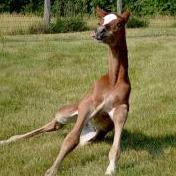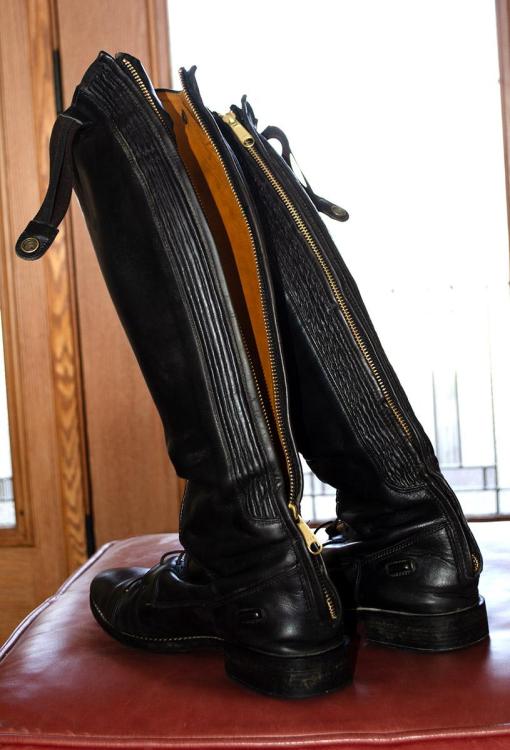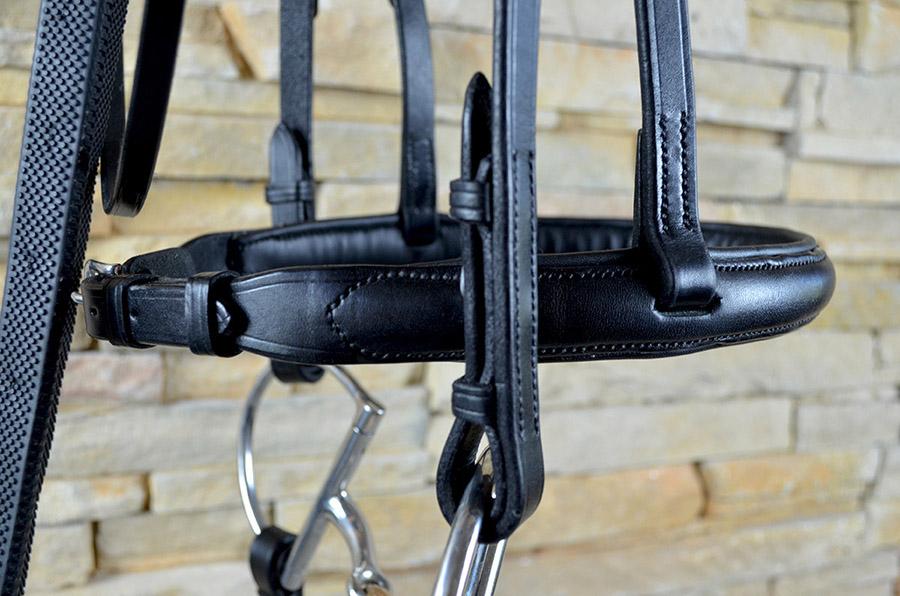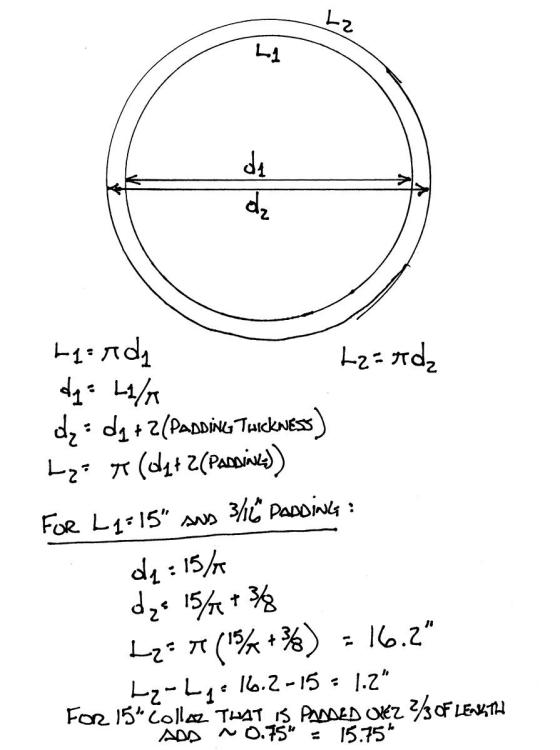-
Posts
1,282 -
Joined
-
Last visited
Content Type
Profiles
Forums
Events
Blogs
Gallery
Everything posted by TomE
-
I think gluing and sewing all the layers would do the trick for constructing it flat than curving into a circle. I'd consider sewing the strap with the dee rings to the wider strap before sewing the pad on the back, unless you're OK with the additional stitching going through the padded layer. Could add some wedge shaped welts on either side of the dee rings. JH Leather videos show this method for the dee on a padded dog collar. Since you're hand sewing with an awl you'll be able to jump over each dee, and possibly overstitch the dee as shown in her videos. That's how I've been fixing the dee to the buckle turn of a dog collar.
- 21 replies
-
- foam padding for leather
- layer
-
(and 2 more)
Tagged with:
-

No room for two needles in stitching holes (pics)
TomE replied to Dannyman's topic in Sewing Leather
I didn't watch the videos, so this might be redundant. To avoid piercing the thread when pushing the second needle through pull the first thread backwards as you advance the second needle then pull up the stitch. This requires clamping the work in a pony/horse/clam so you have both hands free to manage the needles. In the perfect world you would use a sewing awl instead of chisels. Pliers are sometimes needed especially when overstitching at the beginning/end of a stitch line. I wax the thread with beeswax, or a mixture of pine resin-beeswax, which makes my fingers slightly tacky and improves grip on the needles. Stohlman's book on hand sewing covers basic technique and some construction methods. -
I think at the end of the day if the collar fits then you've made the right choice. How tight/loose it fits is a matter of the owner's choice (in my experience for dogs and horses) so this is not an exacting process. I typically measure a collar/bridle that fits to the owner's satisfaction and make mine the same size (plus padding allowance if needed). The calculated padding allowances are small and I only recently did the calculation out of curiosity. I haven't had a problem making dog collars and nosebands as flat straps then wrapping them in a circle. The noseband above is made from 2 layers of 9 oz leather and I've made dog collars in a similar manner. They close in a circle without a problem. I sometimes bend the buckle turn with my fingers to match the curvature (3 layers thick and skived on the end). I am using Hermann Oak regular veg tan or bridle leather. I typically apply a light coat of neatsfoot oil followed by conditioner at the end of the project. Perhaps you could show us pictures of a collar that isn't shaping up.
- 21 replies
-
- foam padding for leather
- layer
-
(and 2 more)
Tagged with:
-
Looks like a winner! That is an interesting girth. Guess you have materials to make all your relatives suspenders for Christmas.
-
That's some nice craftsmanship, Jonas. Not sure if this long dee ring would be large enough. https://www.weaverleathersupply.com/products/571-long-dee
-
The stretch of leather is of interest for saddlery and harness making - how much the length changes with use. I'd be interested in comparing different tannages for stretch under a controlled load. Bridle, harness, and regular veg tanned of similar weight. Also there is some debate about how much the grain contributes to the strength of a strap versus an equal thickness of a flesh side split. How much leather would you need for testing?
-
I knocked my machine out of time when I was learning to sew and this video by @Uwe got me back on track. He also has a video on adjusting the walking foot that is very well done.
-
I quit leathercraft ~50 yrs ago to work on cars (I discovered that girls liked cars). This time around I'd rather work with leather than fuss with machines. Happy to pay a dealer to sort out the machines. Anything other than thread tension and shuttle timing is above my pay grade.
-
For my one experience with sewing a zipper, my double stick tape did not hold so I used a light coating of Barge cement. I was told that this basting tape works well for zippers and will try it next time. https://www.wawak.com/garment-construction/tapes/basting/wawak-hyperstik-super-strong-double-sided-vinylleather-basting-tape-clear/#sku=tpe14
-
Springfield Leather Co has been a good source for me of HO and other leathers. When I go to the store they will open up rolls of HO hides for me to choose from, and most of them look good. When I call in an order I tell them what is important to me and they have delivered, mostly sides of HO bridle leather.
-
Thanks. I think I should have added more attachment points for a pack because my niece won't be wearing this from her belt. I have avoided leather tooling since returning to the craft, although my Tandy tools from the 1970s are sitting in my shop. Was never very good at it and decided to instead focus on cutting and sewing for a while. This sheath is made from the leftover belly of a bridle side. The machete and sheath only recently arrived at my niece's house, a full month after mailing the package. The Saint Louis mail sorting facility swallowed the package for a few weeks. Then there was a problem with the zip code at the destination and it took several weeks to reroute the package to a neighboring post office. All's well that ends well.
-

Help with getting a nice frayed belt edge with fibers
TomE replied to blackandblue50's topic in How Do I Do That?
Bridle leather has prominent fibers and might lend itself to this look. I assume this is related to stuffing the leather with fats and waxes. Rough edges are likely to wear smooth(er) so it might be difficult to preserve the look. -
Welcome! @Northmount provided a tip to use Google's more advanced search engine to search for topics on this site. In the Google search bar type "site:leatherworker.net YOUR SEARCH TERMS HERE" I am finding useful/older threads that I hadn't seen before.
-
I am probably the only one who finds this interesting, but look at how he applies dye. I thought his method produced a pretty shading. I sometimes dye the back of bridle leather after splitting off the pasted/colored back. This looks like a handy way to avoid saturation/bleed through to the grain without the expense and maintenance of a spray gun.
-
This author states "Tokonole's first ingredient is white glue." https://www.fineleatherworking.com/blog/gum-tragacanth-leather/ I haven't purchased Tokonole so I don't know where he got this information. There have been numerous discussions here about using glue-dye mixtures to finish edges as an all-in-one treatment. My tendency would be to apply the dye, wait a few minutes for it to soak in and even out, then apply the bunishing compound and smooth the surface with a glass slicker. I would be concerned that burnishing will obscure the brand.
-
I think @SUP was commenting about creasing and I quoted her. I make padded straps flat and they mold to a round shape with use. Wrinkles and creases aren't an issue in my experience. It would be difficult for me to hand sew them when curved because the jaws of my stitching horse are flat. Here's a noseband that is constructed of 2 layers of 9 oz leather and a neoprene pad wrapped in chrome tanned leather. The 9 oz pieces are skived on the edges, shaped in a rounding block to create the swell, then glued and sewn together with the padding while flat. The noseband readily shapes around a horse's nose. You can see a few wrinkles in the pad but those smooth out with use and are of no concern to the clients I make bridles for. Regarding my original comment on this post, I don't have a wood shop but I do have a calculator on my phone. I had wondered if padding a strap changed the measured size and the answer is -- not much but you can make a small allowance for it, if desired.
- 21 replies
-
- foam padding for leather
- layer
-
(and 2 more)
Tagged with:
-
The pads made from 1/8” neoprene wrapped with 3-4 oz chrome tanned leather are quite flexible there are no major wrinkles. It will depend on thickness/firmness of the pad and the radius of the bend. The dog collars I’ve made are for large dogs.
- 21 replies
-
- foam padding for leather
- layer
-
(and 2 more)
Tagged with:
-
The calculation is for full length padding then I "discount" the allowance based on the fraction of strap length that is padded. In the 15" example, the full allowance is 1.2" and I would add about 0.75" to my strap because only 2/3 of the strap length is padded.
- 21 replies
-
- foam padding for leather
- layer
-
(and 2 more)
Tagged with:
-
I was answering the question of how long to make the strap in order to account for padding underneath, compared to an unpadded strap. The padding will be shorter than the strap, typically spanning between the buckle return and where the buckle holes begin. In my example, the pad is 2/3 the measured length of the collar. The padding is glued and sewn to the strap, and conforms to the strap when buckled. I could make a chart of padding allowances for different length straps, but it depends on the thickness of the padding and how much of the strap is padded. At the end of the day, it is a small allowance (15.75" strap vs. 15" unpadded in my example). For my padding thickness, I can guestimate the allowance from a few reference calculations I made. For example I'd add about 0.5" to the strap length for a dog collar with a measured length of 10". Of course, if the leather stretches then it's a moot point. Why does this matter to me? For a made to order collar or cavesson (bridle nose band) I want it to fit on the middle hole. It is a point of pride.
- 21 replies
-
- foam padding for leather
- layer
-
(and 2 more)
Tagged with:
-
I thought it was only me... I recently was figuring out the allowance for padding a dog collar. I think of it as comparing the circumference of 2 circles. One circle is the unpadded collar and the other is the collar enlarged by the thickness of the padding. In the example below, the circumference of the unpadded collar (L1) is the measured length of the collar from the buckle tongue to the hole it fits into. We know that the circumference of a circle is Pi multiplied times the diameter (d1). We solve for d1 then add twice the thickness of the padding to calculate d2, the diameter of the padded collar. Knowing d2 we can solve for L2, the circumference of the padded collar, which is the length of a strap that fits over the padding. After calculating L2 we can calculate the difference L2-L1, which is the padding allowance for a collar that is padded over the full circumference of the circle. I figure that my collars are padded over ~2/3 of the length, so the padding allowance is 2/3 of the difference (L2-L1). I make padding with 1/8" neoprene wrapped with 3-4 oz leather, which ends up being about 3/16" thick. In the example below, for a measured length (L1) of 15" a fully padded collar would be 16.2" long. Since only the middle 2/3 of the collar is padded I would add an allowance of about 3/4" for the padding = 15.75" Not much change. Hope this helps.
- 21 replies
-
- foam padding for leather
- layer
-
(and 2 more)
Tagged with:
-
I added notched aluminum plates to my Weaver stitching horse, based on a suggestion for sewing straps in the Stohlman hand sewing book. I find this very handy for clamping odd shapes, such as sewing a buckle and fixed loop on the end of a strap, or sewing the edge of a raised leather piece. The space between the tabs works like an ordinary clamp but I often suspend the work between the tabs when I have different thicknesses and odd shapes.
-

Difficulty minimizing tooling marks from machine
TomE replied to Hemskey's topic in Leather Sewing Machines
Great suggestions from @kgg and @Hags. I tap the back side of the stitching with a polished hammer on a smooth stone. Some folks use an overstitch wheel to smooth out the stitching. Also check the type of cutting point on your needle. I think the "S" type cutting points produce less blow out (backside bulges) than the "D" type triangular needles that are good for stiff leather. Here's a guide https://cdn.shopify.com/s/files/1/0579/8857/9507/files/Cutting-Points-schmetz_db_schneidspitzen_6s_20190510_en.pdf?v=1643753018- 5 replies
-
- techsew 4800
- techsew
-
(and 1 more)
Tagged with:
-
He was a handsome boy! Might that be a stallion bridle for showing in hand?
-
I usually mark holes after forming the strap around hardware, but I could then unfold it so I can awl the top layer before gluing/assembly.
-
We all agree it is tough to awl through that many layers, and it's great for me to read everyone's methods. I use a peg awl haft with a 2" awl for the heaviest sewing that I do. https://osborneleathertools.com/product/peg-awl-haft-143/ It's probably the wrong tool for leather sewing but I have gotten the feel of it to reach my destination on the backside of a stack of straps.





